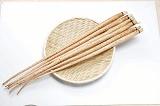Tsurajima Gobou
| Registration Number | 24 |
|---|---|
| Name of the GI | Tsurajima Gobou、TURAJIMA GOBOU |
| Class | Vegetables/ Cereal grains/Pulses |
| Date of Protection | 2016/12/07 |
| Producing Area |
Okayama Prefecture
Kurashiki-City (Mizushima Region, and Nishiachi and Otaka in Kurashiki Region) of Okayama Prefecture |
| Applicant - Name and Address | Harenokuni Okayama Agricultural Cooperatives 1510-1, Tamashimayashima, Kurashiki City, Okayama Prefecture, Japan |
TURAJIMA GOBOU is a white-skinned burdock produced in the Mizushima and Kurashiki areas of Okayama Prefecture. Since it grows fast, it can be harvested quickly and the long sowing period makes the forced cultivation happen three times a year to establish nearly year-round shipment.
The production area is a sandy loam with good drainage. The low sand adhesion allows the burdocks to be pulled out easily so that the whiteness of the skin can be retained. Also, proper fertilization and deep plowing are performed based on the results of soil analysis for quality improvement. The burdocks produced by this method are of equal length and with whitish appearance; they are also both very soft and sweet, and do not leave fibers in the mouth.
Usually, burdocks are shipped with some soil still on them since there were few production areas that wash burdocks before shipping. Shipping of "washed burdocks" began, taking advantage of the soil characteristics of the production area. Also, by immersing them in a tank, time and labor for washing and removing harshness can be saved, so they can be cooked quickly, and eaten with the skin.
Burdocks are dried out after harvesting for easy removal of the sand on the skin. This is done with extra care so as to keep them firm and fresh.
Cultivation of TURAJIMA GOBOU is done three times: first, seeds are sown in September and harvested from January to February. The second seeding is carried out in October, and the third in April.
The production area is in Okayama Prefecture where a tributary of the Takahashi River used to be, accumulating several meters of layers of sandy loam. As drainage is extremely good, water penetrates to the tip of the burdock to promote root growth. Another advantage is that because the area is rich in underground water, irrigation is always adequate. It can be said that the superior characteristics of TURAJIMA GOBOU such as its equal lengths, white skin and little scum are thanks to the location and abundant water channels.
In this area, cultivation of burdock began from around 1947, and as a result of trial and error of various varieties, the "white-skinned" burdock was finally created. From 1979, forced cultivation which made use of its characteristics was introduced, and now it has become the largest washed burdock production center in the Chugoku and Shikoku regions.


